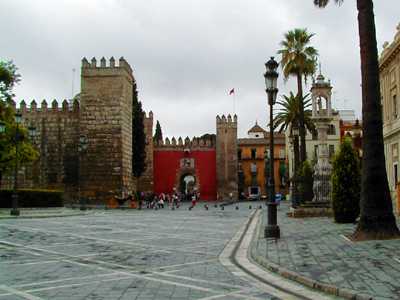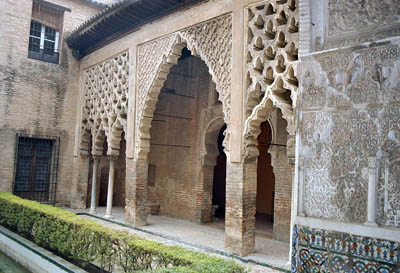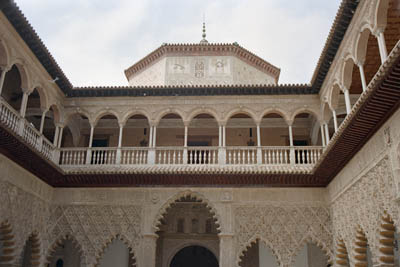Brief history of The Alcázar
From Roman times the area occupied by Los Reales
Alcázares
belonged to a very busy part outside the city. The boundaries of this
part where the Guadalquivir River, the Tagarete stream, the
Via Augusta and curtain walls of the city.
In 711 the Arabs conquered Hispania and the city grew, expanding
outside the old Roman walls. It was even further enlarged the capital
of Al-Andalus a few years later. In 844 the Normans razed a
large part of the city outside the city walls and, as a consequence,
a series of repair works had to be undertaken when the invaders where
defeated. It was during the course of these works in the first years
of the 10th century (913-914) when Ab al-Rahman III ordered
the House of the Governor to be built in what is now the center of the
Alcázar. The parade ground of this initially small fortress
is today's Patio de Banderas, while some of the stony surface
of the walls face today's El Triunfo Square.

During the reign of Kings Al Mutadid and Al-Mutamid
in the 11th century it became necessary to enlarge the original
fortress toward the west, the area of today's Puerta de Jerez
by ading a series of curtain walls with its main gate next to the
river. Remains of this new building are preserved in part of
La Contratación Square where the Royal House used to stand.
During the Almohad government (1147-1237), Sevilla become capital of
the new empire and new alterations where made on the Alcázar.
The interior and exterior Alcázabas where built and joined
the Alcázar with the new city walls from the riverside and by others.
A new military enclosure was built also to the south in a large
triangular area encircled by a new wall that is identified now with
the Huerta de la Alcoba. Near the river another enclosure was
raised in the site where La Casa de la Moneda was later built
and stood attached to the curtain walls of the city and to a wall of
the Palace. This enclosure included the Cicca or Muslim Mint,
La Torre de la Plata (Silver Tower) and even La Torre
del Oro (Tower of Gold).
In 1248 Fernando III El Santo conquered the city of Seville
and the Alcázar became from then onward the residence of the
kings of Castile. His son Alfonso X el Sabio made some
important alterations to adapt these Islamic buildings to the
different needs of his court. The old Almohad palace was rebuilt in a
simple and modest fashion using the Gothic style. This complex consist
of today's Carlos V Halls and the Garden of Doña
María de Padilla. In the middle of the 14th Century, king Alfonso XI
ordered to built the Sala de los Consejos next to the Almohad
Patio del Yeso.

Between the years 1364 and 1366 the Mudéjar palace was built by order
of king Don Pedro. Christian and Muslim master builders from
Toledo and Granada raised the first really rich and sumptuous building
for a Castilian king to live in. The architectural integrity of this
14th century palace is still preserve today, although the building was
subject to different alterations and refurbishing during the course of
several centuries to enlarge and adapt it for the new requirements.
